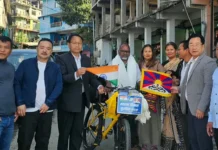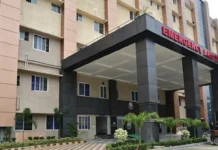[Ripi Bagra]
Nestled along the frontiers of Arunachal Prad-esh, the border villages tell a tale of persistent neglect. Geopolitical tensions have cast a shadow over these remote communities, rendering them vulnerable to isolation and deprivation. The lack of connectivity and infrastructural deficiencies exacerbate their plight, making access to basic amenities, education, and healthcare an arduous challenge. Educational disparities further impede the intellectual growth of the youths, while limited economic opportunities contribute to widespread poverty. Security concerns loom large, sometimes resulting in displacement and adding a layer of hardship. While most nations actively strive to accelerate economic growth and foster emotional integration in their border regions, India, in contrast, deliberately chose to maintain its frontier areas as distinctly isolated through a conscious policy of neglect. This decision was grounded in the misguided notion that neglecting the development of these regions would address India’s security concerns.
Most border villages grapple with severe lack of connectivity, be it Shi-Yomi, Upper Subansiri, Kra Daadi, Dibang Valley, Upper Siang, or Tawang. Inadequate road infrastructure and the absence of reliable transport options make it challenging for the residents to access essential services, educational institutions, and healthcare facilities. This isolation exacerbates the feeling of neglect and marginalisation among the communities. The pervasive underdevelopment has triggered a concerning trend of out-migration towards urban centres, particularly the district headquarters and the Itanagar Capital Region (ICR). The lack of essential amenities and opportunities compels the residents to seek a better life in more developed urban areas. The allure of improved living standards, employment opportunities, and access to essential services in urban settings become a compelling force driving the migration from underdeveloped border areas. This out-migration poses significant security concerns. With fewer inhabitants, these regions become more susceptible to infiltration or activities that may compromise national security. According to the 2011 census, Dibang Valley has 1 person per square kilometre.
Only in recent times has the government shifted its position, allocating funds for diverse developmental initiatives in the region. The government has embarked on a series of initiatives aimed at enhancing connectivity, promoting economic activities, and improving the overall quality of life for residents, such as model villages, Mission Krishi Veer, the vibrant villages programme, the golden jubilee border village illumination programme, ICBRs, etc. However, despite these well-intentioned initiatives, the progress on the ground has been disappointingly sluggish, with the actual impact often falling short of the ambitious goals outlined on paper. The crux of the issue lies in the gap between policy formulation and on-the-ground execution. While these initiatives represent a strategic vision for Arunachal’s development, the translation of these plans into actionable results has been hindered by bureaucratic bottlenecks, corruption, and, in some cases, a lack of coordination among stakeholders. The need of the hour is a critical examination of the implementation mechanisms and a proactive approach to address the challenges hindering progress. Stakeholder engagement, transparent monitoring, and timely course corrections are essential to bridge the gap between policy intent and actual outcomes. Additionally, there is a pressing need for sustained efforts to streamline the administrative processes, allocate adequate resources, and foster collaboration among government agencies, local communities, and other stakeholders.
Only through a holistic and collaborative approach, coupled with proactive measures to address challenges, can the state ensure that these initiatives translate into tangible improvements on the ground, ultimately fulfilling the aspirations of its residents for a better quality of life. The neglect of border villages in Arunachal is a stark reality that demands immediate attention. The story of the neglected border regions reflects not only the failure of adequate policy implementation but also the urgent need for a comprehensive and sustained development agenda. It also underscores the urgent need for targeted efforts in infrastructure development, education, healthcare, and economic empowerment to ensure that no community is left behind in the pursuit of progress. (The contributor is a PhD candidate at Jawaharlal Nehru University, New Delhi)





